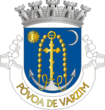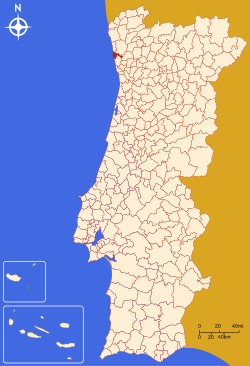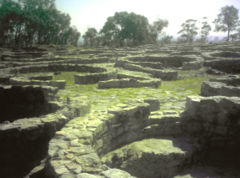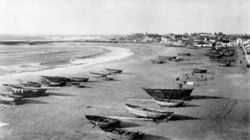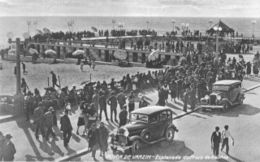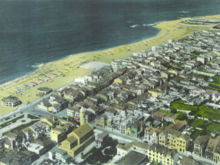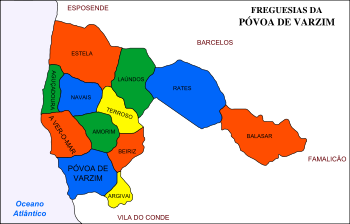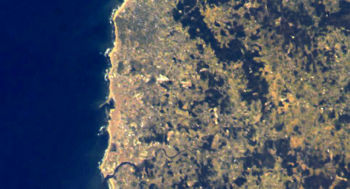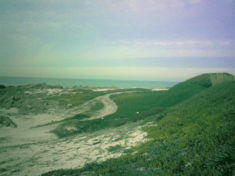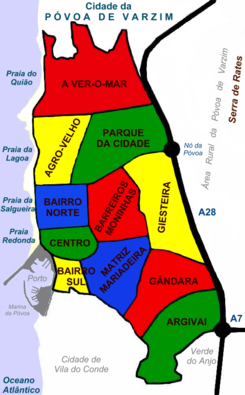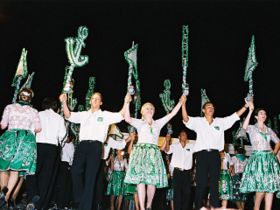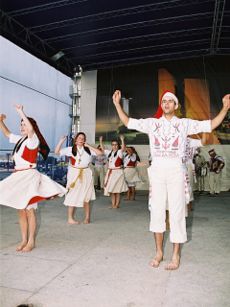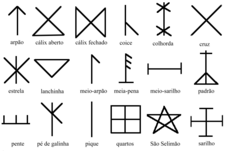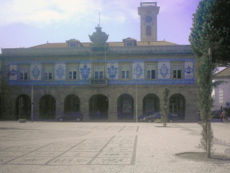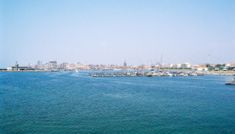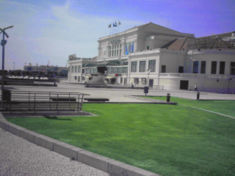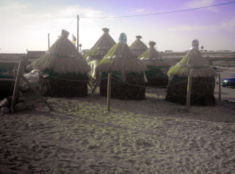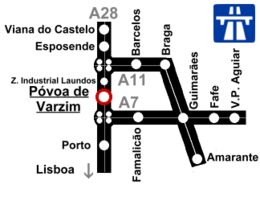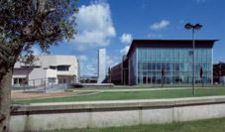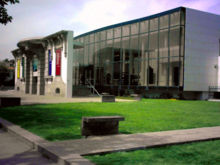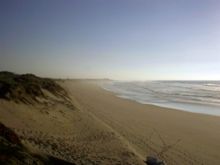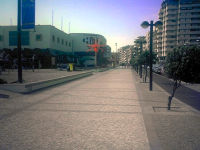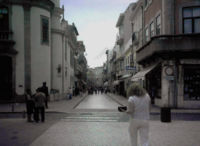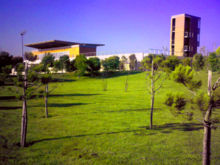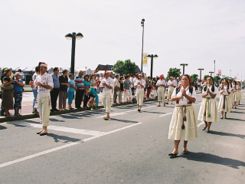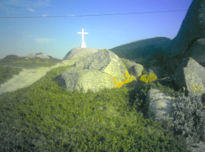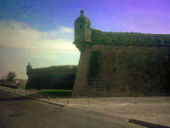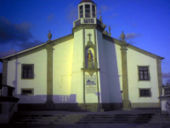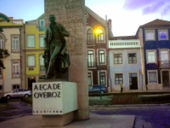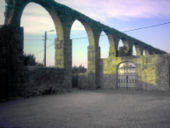Póvoa de Varzim
2007 Schools Wikipedia Selection. Related subjects: European Geography
Póvoa de Varzim ( pron. IPA: ['pɔvuɐ dɨ vɐɾ'zĩ] local pron.['pɔβuɐ dɨ bɐɾ'ziŋ]) is a Portuguese city in the Northern Region and sub-region of Greater Porto, with a 2005 estimated population of 65,882 in its municipality. It is located in a sandy coastal plain, surrounding Cape Santo André, halfway between the Minho and Douro rivers.
Permanent habitation in Póvoa de Varzim dates from around four to six thousand years ago; around 900 BC, unrest in the region leads to the establishment of a fortified city. The ocean has always played an important part in its economy and subsistence, initially through maritime trade, and later through fishing, leading it to acquire a foral in 1308 and consequently to become, in the 18th century, the main fishing port in northern Portugal. Since late 19th century, due to its large beaches, it has become one of the main tourist areas of the region.
Póvoa de Varzim has a rich seafood cuisine and retains ancient customs, such as siglas poveiras and masseiras. It is one of the few legal gambling areas in Portugal and has significant textile and food industries.
History
Discoveries of Acheulean stone tools suggest Póvoa de Varzim has been inhabited since the Lower Palaeolithic, around 200,000 BC. The first groups of shepherds settled on the coast of Póvoa de Varzim between the 4th millennium and early 2nd millennium BC. Their dead were deposited in tumuli, which are the oldest monuments found in the municipality.
Widespread pillaging by rival tribes led the resident populations of the coastal plain of Póvoa de Varzim to raise a fortified town atop the hill that stood next to the sea. Cividade de Terroso thus emerged; it increased in importance and became a major Castro culture settlement. The city area covered 120,000 square metres and had several hundred inhabitants. It maintained commercial relations with the Mediterranean civilizations, specifically during the Carthaginian dominium in the southern Iberian Peninsula.
During the Punic Wars, the Romans became aware of the Castro region's rich deposits of gold and tin. Viriathus, who led Lusitanian troops, hindered the expansion of the Roman Republic north of the river Douro. However, his murder in 138 BC opened the way for the Roman legions. Over the following two years, Decimus Junius Brutus advanced into the Castro region from south of the Douro, crushed the Castro armies, and took Cividade de Terroso, leaving it in ruins.
The region was incorporated into the Roman Empire and totally pacified during the reign of Caesar Augustus. In the coastal plain, a Roman villa was constructed, the property of a Roman family — the Euracini, who mixed with the Castro people who returned to live on the plain — Villa Euracini probably developed in this way. Fishing developed with the cetariæ, a Roman fish factory, chiefly for the production of garum, an Ancient Roman fish sauce condiment and aphrodisiac.
With the fall of the Roman Empire, Suevi populations established themselves in the region. Commencing in the 9th century, Viking fishermen originating from Britanny raised a peaceful colony in Villa Euracini. In the following century, Viking raids took place throughout northwestern Iberia. It was first mentioned as a Portuguese town in March 26, 953 during the rule of Countess Mumadona Dias in the Era of the first County of Portugal. During the Middle Ages, the name Euracini evolved to Uracini, Vracini, Veracini, Verazini, Verazim, and eventually Varazim.
The natural wealth of Varazim's coast attracted aristocrats and nobles to the land. The northern area belonged to a military order, the Knights Hospitaller. It was named Varazim dos Cavaleiros (Knights' Varazim). The southern division of Varazim, the royal land, was important for fishery and agriculture, and because of this, disputes arose over the income brought in by fishing.
In 1308, King Denis conceded a charter (known in Portugal as a Foral), giving the royal land to the 54 families of Varazim; these had to found a type of medieval town known as Póvoa. In 1312, King Denis donated the town to his bastard son, Afonso Sanches, Lord of Albuquerque, who included it in the patrimony of the Convent of Santa Clara, which he had just founded in Vila do Conde. In 1514 during the era of charter reform, King Manuel I gave a new charter to Villa da Povoa de Varzim. The town gained a Town Hall, public square and a pillory, and involved itself in the Portuguese discoveries.
In the 17th century, the brine preservation business developed considerably, which, by the next century, transformed Póvoa into the biggest fish market in the north of the country, supplying even inland provinces via a battalion of hawkers. As a result the Poveiros became known in the region as "the people who most worked and better knew the sea". The community became wealthier; following a royal provision by Queen Mary I, Corregedor Almada reorganized the layout of town so that it finally became attractive and thus provided potential for a new business — sea baths.
In the 19th century, the town became popular as a summer destination for the upper classes of Porto and Minho regions due to its large beaches and the development of leisure and private gambling businesses: in the end of the 19th century, there were 17 illegal casinos, often in the back doors of popular cafés.
On February 27, 1892, a tragedy devastated the community: 105 fishermen were killed in a storm, just metres off the shore.
The thriving state of the textile, food and tourist industries; the rail connection to Porto in 1875; and its development into the most popular holiday destination in northern Portugal, led to a major growth between the 1930s and 1960s, with the result that on June 16 1973, the statute allowing it to be considered a city was finally achieved.
In modern times, the centuries-old fishing industry has lost much of its importance. Póvoa de Varzim is essentially a service-sector city, but unlike other urban areas of Porto, it is not a dormitory community for commuters. In fact, it developed and grew independently: being one of northern Portugal's main locations, it developed a cosmopolitan style and serves as a centre for neighbouring towns.
Geography
Occupying an area of 82.1 square kilometres or 31.7 square miles, Póvoa de Varzim lies between the Cávado and Ave rivers, or, from a wider perspective, halfway between the Minho and Douro rivers on the northern coast of Portugal — the Costa Verde. The city is limited to the north by the municipality of Esposende, to the northeast by Barcelos, to the east by Vila Nova de Famalicão, and to the south by Vila do Conde. To the west, it has a shoreline on the Atlantic Ocean.
Wandering along the coast one discerns Cape Santo André which is, possibly, the Avarus Promontory referred by Ptolemy, geographer of Ancient Greece, in the territory of the Callaici. The rocky cliffs, common features from the estuary of Minho River down, disappear in Póvoa de Varzim giving way to a coastal plain. The plain originates from an old marine plateau conferring a sandy soil to the lands that cross the coast, and forming sand dunes, mainly in northern Aguçadoura.
São Félix Hill (202 m, 663 ft) and Cividade Hill (155 m, 509 ft) are easily visible rising above the landscape. Despite the modest rise, the expanse of the plain makes these easy reference points on the horizon. The mountain chain known as Serra de Rates divides the municipality in two distinctive areas: the coastal plain gives way to hills where the forests become more abundant and the soils have less sea influence. In this landscape dominated by the plain and low hills, only the hill of Corga da Soalheira (150 m, 492 ft), in the interior, is easily recognizable.
The hydrography of the municipality has no large rivers, but abundant small water courses exist due to the relief of the coastal plain. Some of these water courses are permanent, such the Este River, which feeds into the Ave River. The Esteiro River's source is located at the base of Cividade Hill and empties at the beach of Aver-o-Mar while the Alto River's source is at the base of São Félix and reaches the Atlantic at Rio Alto Beach. The land is well-irrigated, the appearance of springs and wells are very common, since underground water is often close to the surface.
The forest areas suffer from strong demographic pressure and intensive agriculture. Forests are still important in parishes surrounded by the Serra de Rates, whose flora is distinguished by the pedunculate oak or the european holly. In 18th century, the monks of Tibães planted pinewood, which today characterizes the civil parish of Estela. In the past the Atlantic forest predominated, with trees from medium to great size, such as oaks, ash trees, hazels, strawberry trees, holm oak, and alders. The rocks throughout the entire coastline are the true fisheries of clams, fish and seaweed. These rocks and the dunes form ecosystems that possess an important ecological wealth, but are threatened by holiday-makers, dune-based sports and coastal constructions.
In the urban sphere, the City Park (800,000 m2) will be extended from the A28 motorway to Pedreira Lagoon and will have densely forested areas, open spaces, hills, a new lake and sports area. In addition, there is Anjo’s Urban Green, which is of environmental importance to the city.
Climate
The city possesses a microclimate and is considered the region least subject to frosts in all northern Portugal due to the winter winds that, normally, blow from south and southwest. The prevailing northern wind (known as Nortada) arise, typically, in the summer after midday, these refresh the air in a climate that is classified as temperate marine.
The municipality has gentle summers and mild winters, with average temperatures oscillating between 12.5 and 15 °C (54.5 and 59 °F). The annual precipitation varies between 1,200 and 1,400 mm (47.2 and 55 inches). Due to proximity, its climate shares many characteristics with the climate of Porto. Sporadically, during its dry summer, a mass of hot and wet air, brought by the south and western maritime winds, creates the city's characteristic fog covering only the coast, which often dissipates with the afternoon sun.
Cityscape
Located in the coastal plain and imprisoned between the sea and hills, the city of Póvoa de Varzim is constituted by eleven Partes (parts), which are significant areas of the city and have population and topological differences. These districts are, in turn, part of three formal administrative structures known as freguesias ( civil parishes): Póvoa de Varzim (parish), A Ver-o-Mar, and Argivai. To the south, there is an urban continuity with the city of Vila do Conde to where the city grew in the past. Most of Póvoa de Varzim’s population growth and commercial development are occurring in the eastern parts of the city.
The city started from an inland town that extended to the coast. The Bairro da Matriz was a significant settlement in the 14th century, whose nucleus was the centre from whence the city grew and is the historical district of the city, being a neighbourhood composed by old single family homes. Bairro Sul grew from the population of fishermen that came from the Matriz neighbourhood and its structure of streets parallel to the coast with fishermen's houses — "beehive of the fishermen" — was already reasonably developed in the 18th century.
Bairro Norte developed at the beginning of the 20th century with streets parallel to the sea, resembling Bairro Sul. In earlier times a fishery district, it became a beach resort and very urbanized (the most populous area with high buildings). This neighbourhood has triggered the development of neighbouring areas, such as Agro-Velho, Barreiros, and Parque da Cidade.
Mariadeira, Regufe, Penalves, and Gândara are old areas, with only modest development, possessing different topologies and of almost exclusively residential nature with small central areas. Downtown (Centro) has the opposite character to the previous ones, in particular Junqueira that became in a commercial district.
Giesteira, which maintains a rural facet in the interior of the city, originated from the old village of Giesteira that, with Argivai, constituted the main nucleus of the settlement before the 14th century, and whose lavradores ( farmers) had helped in the installation of "póvoa" in the coast. Aver-o-Mar developed a distinctive character by mixing both communities, forming a genuine community of fishing-farmers or pescadores-lavradores. With the exception of Santo André, in the northern zone, which keeps an unchanged fishing character identified by family homes that have grown up in a spontaneous way.
The neighbourhoods have greater importance for the inhabitants during the Rusgas in which the most traditional neighbourhoods compete amongst themselves on the night of Saint Peter, part of the city’s festivals.
Ruralscape
The green belt of Póvoa de Varzim is the group of civil parishes known as Aguçadoura, Amorim, Balasar, Beiriz, Estela, Laundos, Navais, Rates, and Terroso. In these rural parishes, beyond the main rural communities, there are smaller villages, namely: Além, Fontaínhas, Gandra, Gestrins, Gresufes, Sejães, and Têso.
The parishes of Beiriz and Amorim are areas of transition between the urban and rural surroundings given that these are close to the city. Beiriz is recognized by its Beiriz carpets and Amorim is popular in the city for its bread, characteristically eaten at high temperatures just after being made — the Broa de Amorim.
In the extensive sandy beaches of the north of the municipality, there are the parishes of the Aguçadoura, Estela, and Navais. The first two have common aspects, such as the beach based agriculture: the masseira fields. Aguçadoura has productive land, supplier of horticultural goods, and Estela became a recreation area. Widely known in Navais is the Fountain of the Enchanted Moorish Girl, on the east of the EN13 road, whose water was used, long ago, to celebrate masses. The people attribute legends and magical virtues to it, believing gold oxens or witches combing their hair appear there during the night.
In the parishes of Laundos and Terroso there are the hills of Póvoa: São Félix and Cividade. During the Middle Ages, Saint Félix would have lived and meditated on the first; on the second there is one of the main cities of the Castro culture, Cividade de Terroso.
Rates is a historic small town that developed around the monastery established by Henry of Burgundy in 1100 on the site of an older temple and gained importance due to the legend of Saint Peter of Rates, first bishop of Braga, becoming in a central place in the Portuguese Way of Saint James. Nearby, the parish of Balasar achieved religious importance and became a pilgrimage destination in the 20th century due to Alexandrina (died 1955) who gained fame as a saint, beatified by Pope John Paul II.
Demographics
|
|
|
A native of Póvoa de Varzim is called a Poveiro. According to the 2001 Census, there were 63,470 inhabitants that year, 38 848 (61.2%) of whom lived in the city. The number goes up to 100,000 if adjacent satellite areas are taken into account. The population of the entire municipality grew only 1% between 1981 and 1991, then increased by 15.3% between 1991 and 2001. During that period, the urban population had grown 23%, with the number of families increasing considerably — by about 44.5%.
The urban area has a population density of 3035/km² (7,864/mi²), while the rural area has a density of 355.5/km² (920/mi²). The rural areas away from the city tend to be scarcely populated, becoming much denser near it. During the summer the resident population in the city triples; this seasonal movement from neighbouring cities is due to the draw of the beach and 29.9% of homes had seasonal use in 2001, the highest in Greater Porto.
According to the Urbanization Plan, the city proper will have a population of 46,170 inhabitants in 2011, representing an increase of almost 19%. The population will continue to be predominantly young (17.5%), though there will be more older people, with the aged population projected to grow to 14.2%. Póvoa de Varzim is the youngest city in Greater Porto with a birth rate of 13.665 and mortality rate of 8.330.
Due to practice of endogamy and the caste system, Póvoa's fishing community maintained its local ethnic characteristics; at the beginning of 20th century, anthropologists had classified the local population as being a Semitic-Norman community, composed of descendants of Phoenicians and Vikings. In a research published in O poveiro in 1908, Fonseca Cardoso considered that a dolichocephalous anthropologic element, the aquiline nose, was of Semitic-Phoenician origin. Anthropological and cultural data indicate Nordic fishermen settling during the period of the coast's resettlement. In the book The Races of Europe, Poveiros were distinguished by having a slightly greater than usual degree of blondism, broad faces of unknown origin, and broad jaws. Other noteworthy settlers were the Castro people (of mixed Celtic and pre-Celtic origin), the Romans, and the Suebi. The population remained heterogeneous for centuries: the man of the coastal area was devoted to fishing, blond or red-haired and well-built; the man from the interior was a farmer with Galician character (typical northern Portuguese), shorter with dark hair.
Poveiros have migrated to other places and this attenuated the population growth. On the other hand, during the emigration period of the 20th century, many Brasileiros (Portuguese emigrants to Brazil) returned to their native land. And, nowadays, the migratory flow is reversed; there is a growing community of Ukrainians, Brazilians, Chinese and Russians. An inflow of people from neighbouring municipalities, who the city now tries to attract, further increases the population.
In 2005, in a study published by the Expresso, Póvoa de Varzim was considered the seventh most developed, in terms of quality of life, among the Portuguese municipalities and the most developed in Porto district. The newspaper Primeiro de Janeiro honoured Póvoa, on the same occasion, as the "city of future" in the Porto district, in fields such as environment, cultural heritage, music, sports, and literary events.
Culture
Poveiro culture is the result of what is found in the Minho Region influenced by the local fishery habits, protected and shaped by local factors over the course of generations. The docudrama film Ala-Arriba! by José Leitão de Barros, popularized this unique Portuguese fishing community within the country during the 1940s. The local expression ala-arriba means "go (upwards)" and it represents the co-operation between the inhabitants and is also the motto of Póvoa de Varzim.
According to a tradition that persists to this day, the youngest son is the heir of the family, as in old Brittany and Denmark, because it was expected that he would take care of his parents when they became old. Women govern and lead the family, because men were usually away from home fishing.
Formerly, the population was divided into different " castes": The Lanchões (those who possessed boats which were capable of deep-water fishing, therefore more prosperous), the Sardinheiros (those who possessed small boats and could only catch fish of smaller size along the shore) and the Lavradores (the farmers). As a rule, the three groups remained distinct, and mixed marriages between them were forbidden, mostly because of the isolationism of the fishermen who were headed by a group of patriarchs.
Siglas Poveiras are a form of proto-writing system, with a restricted number of symbols that were combined to form more complex symbols; these were used as a rudimentary visual communication system, and as a family coat of arms or signature to mark belongings. Merchants wrote them in their books of credit; fishermen used it in religious rituals by marking them in the door of Catholic chapels near hills or beaches; in the table of their town’s first church during marriage; and also had magical significance, such as the São Selimão sigla , that could be used as a protecting symbol and not as family mark. Children used the same family mark with piques as a form of cadency. The youngest son would not have any pique and would inherit the marca-brasão, his father's symbol. The siglas are still used, though much less commonly, by some fishing families; and are, possibly, related with Viking traditions.
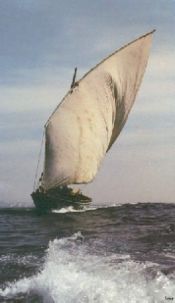
The camisolas poveiras are local pullovers, with fishing motifs and name embroidered in sigla, made for celebration and decorative purposes. The pullovers were a local dress until 1892, when a misfortune at sea led the community to stop wearing it. It became popular again at the end of the 1970s. Today, there are efforts to modernize it on one hand and on the other there are endeavours to preserve the long-established practices. Other typical handicrafts are the Tapetes de Beiriz or Beiriz carpets, which are characteristic carpets renowned and demanded nationally and internationally.
Due to modern national influences, some local traditions started to be lost: the caste structure perished; the traditional casamento poveiro, in which the newly-wed couple was covered by a fisherman's net and watered with vinho verde in order to bring fortune to the marriage, is becoming a forgotten practice; the lancha poveira, which was formerly common around the beaches of Póvoa, was gone by the 1950s.
The most traditional ingredients of the local cuisine are locally-grown vegetables and fish. The fish used to create the traditional dishes are divided in two categories, the "poor" fish ( sardine, ray, mackerel, and others) and the "wealthy" fish (such as whiting, snook, and alfonsino). The most famous local dish is Pescada à Poveira (Poveira Whiting), whose main ingredients are, along with the fish that gives the name to the dish, potatoes, eggs and a boiled onion and tomato sauce. Other fishery dishes include the Arroz de Sardinha (sardine rice), Caldeirada de Peixe (fish stew), Lulas Recheadas à Poveiro (Poveiro stuffed squids), Arroz de Marisco (seafood rice) and Lagosta Suada (steamed lobster). Shellfish and boiled iscas, pataniscas, and bolinhos de bacalhau are popular snacks. Other dishes include Feijoada Poveira, made with white beans and served with dry rice (arroz seco); and Francesinha Poveira made in long bread that first appeared in 1962 as fast food for holidaymakers.
Government and politics
| Civil parishes of Póvoa de Varzim | |
|
|
The city of Póvoa de Varzim is governed by a Câmara Municipal (City Council) composed of nine councilmen. A Municipal Assembly exists and it is the legislative body of the municipality, consisting of 39 members, twelve of whom are presidents of civil parishes. After the 2005 municipal elections, six councilmen were members of the centre-right Partido Social Democrata (PSD) and the remaining three of the centre-left Partido Socialista (PS). The mayor is Macedo Vieira, for the PSD, elected with 54.21% of the votes. The PSD holds the majority of public offices both in the Municipal Assembly and in the civil parishes.
After the first free elections, with the end of the Estado Novo period, only right-wing parties have governed the city: the city council was governed by the CDS between 1976 and 1989 and since then by the PSD. The CDS saw its popularity suffer an abrupt decline in 1997, and has since then been the third political party. On the other hand, the PSD in the same year achieved its first absolute majority with 62.4% of the votes.
Between 1308 and 1836, the municipality was made up of a single parish territory of which, over time, grew to approach the medieval borders. With the administrative reform of the territory in 1836 Póvoa began to control the territories: the council of Rates was annexed, the lands of Argivai recouped, and other parishes acquired.
Póvoa de Varzim is the northernmost municipality in the Porto Metropolitan Area, about 27 km (16 mi) north of downtown Porto. Despite being enclosed in the northern metropolis, Póvoa de Varzim is part of the Association of Municipalities of the Ave Valley. Within the context of the European Union, Póvoa de Varzim is twinned, since 1986, with the city of Montgeron in France with which it has a very close relation, and due to this, it received two Golden Stars of Town-twinning from the European Commission (1995 and 2005). It also has friendship agreements with Eschborn in Germany (since 2000) and Żabbar in Malta (since 2001).
Economy
The economy of Póvoa de Varzim is driven by tourism (namely gambling, hotels and restaurants), manufacturing, construction, fishing, and agriculture. During the 2001 census, 1770 companies were headquartered in Póvoa de Varzim, of which 2.82% were of the primary sector, 33.73% of the secondary and 63.45% of the tertiary, including some software companies operating nationally and abroad. Despite its weight in Greater Porto international trade is weak, in 2004 it represented 1.1% of departures and 0.9% of arrivals, its coverage rate of arrivals against departures suppressed the 100% mark. The activity rate had grown from 48% to 51.1% from 1991 to 2001, but there were 3353 citizens unemployed in June 2006.
The fact that it is a seaside city has shaped Póvoa de Varzim's economy: the fishing industry, from the fishing vessels that put in each day to the canning industry and to the city's fish market, beach agriculture, seaweed-gathering for fertilizing fields, and tourism are the result of its geography. Tourism and the related industries are more relevant in Póvoa's economy these days, as fisheries have lost importance. Nevertheless, the mean value of fish landed in 2004, in its seaport, was almost three times that of Matosinhos seaport and significantly higher in the average vessels' capacity. Its fishing productivity is also comparatively higher than the national average.
Energy self-sustainability is foreseen with the installation of the world's first wave power plant, the Okeanós. This plant, consisting of three Pelamis devices, is being installed north of the city. In the first phase (2006), the park will produce 2.25 megawatts, enough energy for 1500 homes. In 2008, it is expected that the Okeanós will become a true plant consisting of 28 machines capable to produce 24 mW, supplying 250 thousand inhabitants, 10% of that energy, (capable of supplying one third of the population of the municipality) will be assigned to the city.
The manufacturing industry is still an important employer, mostly in the textile industry that has low productivity and income. These industries are located out of the city in Beiriz, Balasar, and Rates. Other employers include the blanket handicraft industry of Terroso and Laundos, rope making, and the wood industries of Rates. One of the thriving initiatives of the municipality is the Parque Industrial de Laundos (Industrial Park of Laundos) that is in close proximity and linked to the A28 Motorway.
Despite being a small municipality, Póvoa de Varzim is one of the principal food suppliers for Greater Porto and is part of the ancient Vinho Verde winemaking region. The coastal populations developed the masseira farm fields. The masseira technique increases agricultural yields by using large, rectangular depressions dug into sand dunes, with the spoil piled up into banks surrounding the depression. Grapes are cultivated on the banks to the south, east and west, and trees and reeds on the northern slope act as a windbreak against the prevailing northern wind. Garden crops are grown in the central depression. Large amounts of fresh water are required to irrigate the crops, together with sargassum seaweed for fertilisation. Production is still specialized in horticultural goods, but most of the masseiras were substituted by greenhouses. On the other hand, the interior region is dedicated to milk production. The Agros Enterprise Centre (part of Lactogal, the largest dairy products and milk producer company in Portugal) is under construction and will be the headquarters of the company and will have several departments such as exhibition park and laboratories, thus becoming the largest agricultural project in the north of Portugal.
Transport
The city of Póvoa de Varzim is served by a well-developed transportation network that employs maritime, aerial and terrestrial travel. The terrestrial access infrastructure is composed of national motorways ( freeways), the national roads system, and metro trains. These infrastructures and the airport, bus terminal, marina and harbour are used daily by thousands of people to travel to the city.
The city is connected by road on a north-south axis from Valença to Porto by the A28 motorway. It is also reached by the A7 and A11 motorways on a east-west axis, through the south and north of the city, in that order, and both cross the A28.
The Francisco Sá Carneiro Airport (OPO) is located 18 km (11 mi) south of the city. It is the second biggest international airport in Portugal and serves all Greater Porto. The Póvoa de Varzim Bus Central is a terminus for urban and long distance buses also used as an entrance for travellers arriving from national cities, as well from other European cities. The Line B of Porto Metro links Póvoa de Varzim to Porto with two services: a standard and a shuttle (the Expresso); through Verdes station, Metro trains link the city and the airport.
The traditional road system of the city, composed of roads that run parallel in the direction of the sea, can be seen in any of the following avenues: Avenida do Mar, Avenida Vasco da Gama, Avenida Mouzinho de Albuquerque, and Avenida Santos Graça. The Avenida dos Descobrimentos and Avenida dos Banhos, in other hand, run parallel to the coast. The growth of the city inland and northwards made ring roads more important, this can be seen in the setup of the B and C ways, inner and outer belt roads.
Although it lost usefulness for average and long distances, the National Roads system has acquired municipal interest: EN13 that cuts the city in half in a north-south direction, is used by commuters originating from the northern parishes and from the city of Vila do Conde, in the south, to travel downtown. The EN205 and the EN206 are used by commuters starting from the interior of the municipality.
Healthcare and security
The first healthcare structure, the Santa Casa da Misericórdia da Póvoa de Varzim (Holy House of Mercy), opened in 1756. The hospitals of the city are the Hospital São Pedro Pescador (state-run) and HOSPOR Clipóvoa (private). The public hospital suffers from lack of quality bed spaces. Due to this, there is an on-going plan to build a modern hospital, in the border between the cities of Póvoa de Varzim and Vila do Conde, to serve the population of both municipalities. The Centro de Saúde da Póvoa de Varzim (Health Centre) is a public primary care building which has extensions in the main parishes.
Policing in Póvoa de Varzim is provided by the Municipal Police of Póvoa de Varzim and national polices. The Municipal Police of Póvoa de Varzim, one of the first to be established in the country, is an administrative police force that acts solely within the municipality and reports directly to the President of the City Council.
The Escola Prática dos Serviços, just east of the city by the A28 motorway, is the national headquarters for military administration instruction, with the Battalion of Military Administration, and, due to the reorganization of army services, the former Escola Prática de Administração Militar, from 2006 onwards it gained the material and transport services, thus increasing its range of functions and troop numbers.
In terms of crime, Póvoa de Varzim is considered by the Polícia de Segurança Pública as a "calm" zone in all categories of offense; violent crime, in particular, is practically non-existent. Mostly, crime consists of minor robberies of homes, stores, or from cars.
Education
Póvoa de Varzim has public, denominational and independent schools in the city and rural areas. Public education in the municipality is provided by five school districts: Flávio Gonçalves, Cego do Maio, Aver-o-Mar, Campo Aberto, and Rates. These school districts arrange kindergartens and schools to the 9th grade of different locales of the municipality and are headed by Escolas de Educação Básica do 2.º e 3.º Ciclos (6th to the 9th grade schools) that give the name to the respective districts. Private schools in Póvoa de Varzim are primarily run by catholic parishes or groups, but the Grande Colégio da Póvoa de Varzim and Campo Verde School of Agriculture are eminent independent schools and MAPADI is a large facility and school for children with down syndrome.
High schools (10th to the 12th grade) are situated in the city centre: Escola Secundária Eça de Queirós and Escola Secundária Rocha Peixoto. The Colégio de Amorim is an independent school in the civil parish of Amorim that also offers secondary education. Eça de Queirós was a lyceum created in 1904 that maintains its humanist outlook and Rocha Peixoto was a former industrial and commercial school created in 1924.
The Porto Polytechnic runs, jointly in Póvoa de Varzim and Vila do Conde, the Superior School of Industrial Studies and Management (ESEIG), which once was based in two campuses (one in each city), but it was united in a single new school, on the border between the two cities. A little more than one quarter of the population now has intermediate or superior level qualifications. The illiteracy level in Póvoa de Varzim was reduced between 1991 and 2001 from 7 to 5.9 percent.
Arts
Póvoa de Varzim is strongly associated with Portuguese literature. It was the city where Eça de Queirós, one of the main writers in the Portuguese language, was born; and where José Régio passed his free time writing (mostly in Diana, a writers meeting place that is currently the beach library). Other famous writers closely associated with the city are Almeida Garrett, Camilo Castelo Branco, António Nobre, and Agustina Bessa-Luís. The Rocha Peixoto Municipal Library, established in 1880, on the 300th anniversary of the death of Luís de Camões received in 1913, as an inheritance, the private library of the Poveiro scientist Rocha Peixoto and, after some relocation, was finally housed in the current building in 1991.
The city organizes international meetings, one of which is the Correntes d'Escritas between writers from countries where Iberian languages are spoken, specifically from Portugal, Spain, Brazil, Lusophone Africa and Hispanic America. Another erudite event of the city is the International Music Festival of Póvoa de Varzim, that, in 2006, commemorated its 28th year.
The Filantrópica, created in 1935, has as its purpose the execution of cultural activities, inducement to artistic creation, and aid in the integration of Eastern European immigrants (represented by free classes in Portuguese and paid classes of Russian). The Varazim Teatro is a cultural and youth group of amateur theatre that has encouraged local drama. The municipal auditory of Póvoa de Varzim had been created in early 21st century and is where the School of Music of Póvoa de Varzim and the Octopus Film club with exhibitions of quality cinema coexist.
The Ethnography and History Municipal Museum of Póvoa de Varzim was established in 1937 by António dos Santos Graça in order to preserve the Poveiro’s practices and traditions which were being lost without record or research. Two themed museums exist: the Museum Nucleus of the Romanesque Church of Saint Peter of Rates which is dedicated to the dissemination of the history, legend and art surrounding the Romanesque Church of Saint Peter of Rates, and the Archaeological Nucleus of Cividade de Terroso, which serves as a presentation of Cividade de Terroso. The Arquivo Municipal is the city's archive planned for those who are interested in tracing their own family pedigree chart or scrutinize the city's records.
Leisure and entertainment
Póvoa de Varzim's beach is a 12 km stretch of golden sands, with water temperatures roughly 18 degrees Celsius during the summer; but notable for being rich in iodine. The beaches of the city: Redonda, Salgueira, Lagoa to Fragosa are very popular to locals and visitors. The beaches to the north: Quião, Santo André, Aguçadoura, and Rio Alto, where sand dunes formed, have hassle-free surroundings. The latter, given its difficult access and the privacy offered by the sand dunes, is frequently chosen by naturists, even though it is not official, nearby there is a camping park and other venues.
Several beaches are divided by rocks, and in Verde Beach there are ruins in a rocky formation. Thus, the beaches have raised the city’s profile in the north and are responsible for the development of leisure activities in the city. The Casino da Póvoa is a central gaming and entertainment location in the North since the 1930s, where gambling and shows take place throughout the year.
Passeio Alegre is used by locals and visitors to take a walk along the beaches of the city. It is a popular nightlife area during the summer and weekends. Younger Poveiros meet at the night in the bars near Passeio Alegre, mostly in Passeio Alegre Square, but as well in the Carvalhido, Lota and Lagoa Beach, before going on to the nightclubs, located in the two extremities of Passeio Alegre, very late at night.
Póvoa de Varzim's busiest shopping district is Junqueira, whose central street has been solely pedestrian since 1955 and renowned, nationwide, for its jewellery. It is rich in 19th century and early 20th century buildings. Some of the nearby streets have also become pedestrian. Restaurants are located for some kilometres along the EN13 road that crosses the interior of the city, especially in the northern section. Quite a few are well-known and reputed due to Portuguese barbecued chicken, seafood, francesinha, bacalhau or even due to sexy waiters.
São Félix Hill possesses windmills converted into tourist accommodation with panoramic views over the city, the hilltop is reached using the São Félix stairs. Póvoa de Varzim has varied hotels, some of which include the Grand Hotel (Mercure Hotel), built in the 1930's, neighbour of the casino; and the inns installed in the Santo André Beach, on the top of the São Félix hill and near the golf course.
Sports
The city has developed a number of sporting venues and because of that it has hosted several national, European and world championships in different sports. 38% of the population practise sport, a high rate when compared to the national average.
The most popular sport in Póvoa de Varzim is the association football. The City Park's Stadium and synthetic fields for football practice and athletics are today the main stage for Póvoa de Varzim's People's championship where its 19 people's football clubs compete: Aguçadoura, Amorim, Argivai, Averomar, Balasar, Barreiros, Beiriz, Belém, Estela, Juve Norte, Laundos, Leões da Lapa, Mariadeira, Matriz, Navais, Rates, Regufe, Terroso, and Unidos ao Varzim. Varzim SC is the professional football club of the city; as of 2006 it plays in the Liga de Honra (2nd level), but several times has reached the Portuguese Liga.
Swimming is the second most popular sport; it is practised in school or in the swimming pool complexes near the beach. One of the complexes belongs to Varzim Lazer, a municipal company that runs the sports equipment found north of the city: the tennis academy, the bullfighting arena, the municipal pavilion, along with the swimming pools. The other complex is property of Clube Desportivo da Póvoa, a club that is notorious, in the city, because it competes in several sports: rink hockey, volleyball, basketball, athletics, and auto racing.
The Casino da Póvoa Rally is a rally racing event taking place along the Minho region, starting and ending in the city. In athletics, Póvoa de Varzim organizes the Cego do Maio Half Marathon and the São Pedro Grand Prix in the city’s streets. The first one aims at the promotion of the city and among the population; the second is part of the national calendar of the Portuguese Athletics Federation.
The marina near the seaport offers several sport activities developed by the Clube Naval Povoense, especially sailing, sport fishing, and surfing. One of the regattas organized by the club is the Costa Verde Trophy, linking the coastal cities of Póvoa de Varzim and Viana do Castelo. The marina of Póvoa is a stop for boats that are exploring the west Iberian coast. It is located in a sheltered area and provides facilities with boatyard services.
Near São Félix Hill, the São Pedro de Rates shooting camp is considered one of the best in Portugal and in Europe, with great prestige among nationals. There is also a links golf course and a greyhound racing track in Estela. The Monumental Praça de Touros da Póvoa de Varzim is the only active bullfighting arena in northern Portugal. Today, the most important run of this arena occurs in late July, with the "Grande Corrida TV Norte" (TV's Great Run North), an event that follows the bullfighting Portuguese tradition, which is a variety of bloodless and skilful bullfighting. A harmless, traditional and fun bullfight, known as Garraida, with young bulls and students occurs in the beginning of May as part of Porto's student festivities - the Queima das Fitas.
Festivals
There are several religious or popular celebrations (singular festa, plural festas). The city's holiday is June 29, Saint Peter's day, the fisherman saint. The neighbourhoods are decorated; and, on the night of 28th to 29th the population gets together in celebration, dancing and eating by the light of fires. The traditional neighbourhoods compete in the rusgas (a sort of carnival) and the creation of thrones to Saint Peter. During the festivities, the population behaves much like football supporters, and occasionally there are disturbances when fans defend their preferred district; but the competition is usually very healthy. Families, having previously emigrated to the United States and beyond, have been known to come back to Póvoa, time and again, simply to relish the spectacular feelings of excitement and community present at this festival.
Easter Monday is considered to be the second "municipal holiday". The populace works on Good Friday (national holiday) to have Monday free to picnic (Anjo festival). The local companies follow this tradition and are open on Friday and closed on Monday.
On August 15 there is the Feast of the Assumption, one of the largest of this kind in Portugal, the pinnacle of the procession occurs in front of the seaport, where fireworks are launched from carefully arranged boats. In the last fortnight of September, during the Senhora das Dores festival, there is the century-old Senhora das Dores Pottery Fair, with many tents, installed in the square near the Senhora das Dores Church, which sell diverse wares of traditional Portuguese pottery.
São Félix Hill is a reference point for fishermen at sea. On the last Sunday of May, the Pilgrimage of Nossa Senhora da Saúde (Our Lady of Health) covers a distance of 7 km (4.25 mi) between the Matriz Church and the Nossa Senhora da Saúde Chapel, at the foot of São Félix. In Cape Santo André there is a rocky formation known as Penedo do Santo or Saint's Rock, which has a mark that the Poveiro fishermen believe to be a footprint of Saint Andrew (Santo André). They still believe that this saint is the "Boatman of Souls" and that he frees the souls of those who drown in the sea, fishing them from the depths of the ocean after a shipwreck. The celebration of Saint Andrew occurs on the dawn of the last day of November, when groups of men and women, wearing black hoods and holding lamps, go to the chapel via the beach.
Architecture
- Nossa Senhora da Conceição Fortress (mostly known as castelo), built in the reigns of Peter II and John V (between 1701 and 1740) to defend the town from pirate attacks, in the site of an earlier fort.
- Solar dos Carneiros, an 18th century nobleman's house. It became a museum in 1937; in it, visitors can become acquainted with previous generations of Poveiros.
- Churches:, emphasizing the thousand-year-old church of São Pedro de Rates (national monument and and one of the main medieval Romanesque buildings in Portugal); the 17th century's baroque Matriz Church with its rich rococo altarpiece, filled with siglas poveiras; the 17th century's and fishermen's Lapa Church, with its old lighthouse which was once a link between the church and the fishermen on the sea; the 18th century Senhora das Dores church with the pains of Mary sculptures in several chapels; and the Balasar church with the remnants of Alexandrina of Portugal in the village of Balasar.
- City Council, building of neoclassical style, influenced by the English colony of Porto, conceived in 1790 to lodge the city council of Póvoa de Varzim. The Coreto of Póvoa de Varzim is located in the same square.
- Cividade de Terroso, a 3000 year-old Castro town, the cradle of Póvoa de Varzim. Archaeologists from northern Portugal and Galicia (northern Spain) are preparing a joint submission to UNESCO in order to classify Cividade de Terroso as a World Heritage site.
- Castros: beyond the main Castro settlement, three of Cividade de Terroso’s outposts are known: Castro de Laundos (mostly unexplored), Castro de Navais (only the fountain and site remains, due to the fact that it is inhabited to this day), and Castro de Argivai (severely damaged).
- Aqueducts: Aqueduct of Santa Clara (national monument), raised between 1626 and 1714, was composed of 999 archs taking the waters from the spring of Terroso for the convent of Santa Clara in Vila do Conde, and remaining portions of the Aqueduct of Coelheiro (18th century), an aqueduct that formerly supplied Praça do Almada.
- Fountains: Of several sources, ancestral fountains gain relevance due the fact that the population attribute legends and miraculous or therapeutic effects to them: the two Fountains of Saint Peter of Rates (in Balasar and Rates) and the Fountain of the Enchanted Mourish Girl, in Navais.
- Pillories: The manueline pillory of Póvoa de Varzim built in 1514 is a national monument; the pillory of Rates also from the 16th century is a listed property of Public Interest.
- Sculptures. Amongst other monuments the most distinguished are:
- Cego do Maio — local hero. By Poveiros of Brazil in 1909.
- Cruzeiro da Independência — 800 years of the independence of Portugal. By the National Body of Scouts in 1940.
- Eça de Queiroz — the most notable among the Poveiros. By Poveiros of Brazil in 1952,
- Millennium Mark — commemorates 1000 years — from March 26, 953 — of the recorded existence of Póvoa de Varzim.
- To Poveiro peoples — honouring the unity of the municipality and the difference between the fisherman of the coast and the inland farmer. By the Rotary Club of Póvoa de Varzim in 1995.
- Saint Peter — patron saint. Saint Peter Festival of 1996.
- To the Fisherwoman / Poveira Woman — honours the central role of women in the daily life of the community. Saint Peter Festival of 1997.


